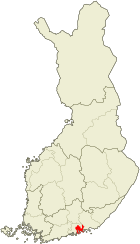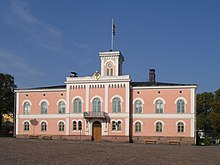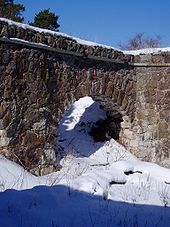Loviisa
| coat of arms | map |
|---|---|

|

|
| Basic data | |
| State : |
|
| Landscape : | Uusimaa |
| Administrative community : | Loviisa |
| Geographical location | 60 ° 27 ' N , 26 ° 13' E |
| Surface: | 1,751.58 km² |
| of which land area: | 819.62 km² |
| of which inland waterways: | 25.83 km² |
| of which sea area: | 906.13 km² |
| Residents : | 14,891 (Dec. 31, 2018) |
| Population density : | 18.2 inhabitants / km² |
| Municipality number : | 434 |
| Language (s) : | Finnish , Swedish |
| Website : | loviisa.fi |
Loviisa [ ˈlɔviːsɑ ] ( Swedish Lovisa ) is a city in southern Finland with 14,891 inhabitants (as of December 31, 2018). It is located on the south coast of the country in the Uusimaa region (until December 31, 2010 in the Ostuusimaa region ). Around forty percent of the population are Finland-Swedes . The main attractions of Loviisa are the historic city center and the island fortress Svartholm . The city has a seaport and is the location of the Loviisa nuclear power plant .
geography
Loviisa is located in the southern Finnish region of Uusimaa on the coast of the Gulf of Finland . The next largest cities are Porvoo 37 kilometers west and Kotka 46 kilometers east. Finland's capital Helsinki is 87 kilometers to the west. Neighboring towns and municipalities of Loviisa are Porvoo in the west, Myrskylä in the northwest, Lapinjärvi in the north, Kouvola in the northeast and Pyhtää in the east.
In addition to the actual core town, Loviisa has included a larger area in the surrounding area since the incorporation of three neighboring communities in 2010. In total, the administrative urban area of Loviisa, excluding the marine areas, has an area of 845.5 square kilometers. In addition to the city center, Loviisa has eight other settlement centers ( taajama ): the parish villages of Pernå (Pernaja), Ruotsinpyhtää (Strömfors) and Liljendal, as well as the towns of Forsby (Koskenkylä), Gammelby (Vanhakylä), Isnäs , Kuggom and Tesjoki (Tessjö).
As is typical for the coastal areas of Uusimaa, the landscape in Loviisa is flat and is characterized by forests and agricultural areas. The coastline is strongly indented with numerous bays, peninsulas and offshore archipelago . The largest islands are Sarvsalö (Sarvisalo) with 28 and Vahterapää with 21 square kilometers. Three rivers flow through the urban area: In the east, the Ahvenkoskenhaara, an estuary of the Kymijoki , marks the municipal boundary to Pyhtää. The Loviisanjoki River flows into the Loviisanlahti Bay near the core town of Loviisa, and the Koskenkylänjoki flows into the Pernåviken Bay near Pernå .
history
The previously sparsely populated coastal area around Loviisa came under the influence of the Swedish Empire in the Middle Ages and was settled by new settlers from Sweden in the 13th century. From the 14th century the area belonged to the parish of Pernå (Pernaja). The King's Road ran through the area from Turku (Åbo) to Viipuri (Vyborg).
After Sweden lost the city of Hamina (Fredrikshamn) to Russia in the Treaty of Åbo in 1743 , south-eastern Finland needed a new port. Therefore, in 1745 the town of Loviisa was founded on the lands of the Degerby manor. At first the city was also called Degerby, in 1752 it was renamed Lovisa (Loviisa) after the Swedish Queen Luise Ulrike (Lovisa Ulrika). To protect the eastern border, the sea fortress Svartholm was built in front of Loviisa in the 1760s . Another planned fortress on land, which was to be built north of Loviisa, remained unfinished except for two bastions.
During the Third Russo-Swedish War , Svartholm fortress surrendered to the besieging Russians in 1808. As a result of the war, Loviisa, like all of Finland, came to Russia the following year and became part of the newly established Grand Duchy of Finland . Loviisa remained a garrison town until the British Navy destroyed Svartholm Fortress during the Crimean War in 1855. In the same year there was a serious city fire in Loviisa, which, however, spared the wooden old town.
Shortly after Finland declared its independence from Russia in 1917 , the Finnish Civil War broke out. Loviisa was initially held by the bourgeois “whites” protective corps, but then came under the control of the socialist “reds” like all of southern Finland. After Germany had sided with the whites, a German unit with a strength of 2,500 landed in Loviisa on April 7, 1918 as part of the so-called Finland intervention and conquered the city without resistance.
At the beginning of 2010, the neighboring communities of Pernå , Ruotsinpyhtää and Liljendal were incorporated into the town of Loviisa. As a result, the population of Loviisa doubled, the area even increased twentyfold.
population
At the turn of the year 2009/2010 Loviisa had 15,549 inhabitants. Almost half of the population lives in the urban area before the municipal merger, the rest in the surrounding area.
The coastal area of Uusimaa traditionally belongs to the settlement area of the Finland Swedes . Of the residents of Loviisa, 54.5% speak Finnish and 43.0% speak Swedish as their mother tongue. The city of Loviisa is now officially bilingual with Finnish as the majority and Swedish as the minority language. Of the former parishes that were absorbed into Loviisa, Loviisa and Ruotsinpyhtää were mostly Finnish-speaking, in Pernå and Liljendal Swedish was the majority language.
politics
City council
The Loviisa City Council, the highest decision-making body in local affairs, has 59 members. He was re-elected during the current electoral period due to the parish merger in October 2009 and started work at the same time as the parish merger at the beginning of 2010. The strongest parliamentary group is the Swedish People's Party , the political representation of Finland-Swedes, with a good forty percent of the vote and 25 seats on the city council. They are followed by the Social Democrats and the Conservative Raising Party, two of Finland's three major parties, with 14 and eight MPs respectively. The country's strongest party, the Center Party , plays only a minor role in Loviisa, with an election result of around five percent and three seats on the city council. The right-wing populist “ True Finns ” and the Green Bund also represent three MPs . The left alliance , the independent electoral list Uuden Loviisan sitoutumattomat - De obundna i det nya Lovisa and the Christian Democrats , each with one seat , are also represented in the city council .
| Political party | Election result | Seats |
|---|---|---|
| Swedish People's Party | 40.6% | 25th |
| Social democrats | 23.0% | 14th |
| Collection party | 13.1% | 8th |
| True Finns | 5.8% | 3 |
| Green covenant | 5.3% | 3 |
| Center Party | 5.1% | 3 |
| Left alliance | 2.3% | 1 |
| Independent | 2.1% | 1 |
| Christian Democrats | 1.6% | 1 |
coat of arms
The coat of arms of Loviisa goes back to the seal that the city received from King Adolf Friedrich in 1756 . In its current form, the coat of arms was drawn in 1969 by the heraldist Ahti Hammar. The blazon of the coat of arms reads: In the blue and gold divided shield are two crossed golden cannon barrels at the top and a black anchor at the bottom . There is a crown on the shield .
Economy and Infrastructure
Loviisa is the location of the Loviisa nuclear power plant operated by the Fortum Group . The nuclear power plant is located around 15 kilometers southeast of the city center on the island of Hästholmen. It houses two of Finland's four current reactor blocks. The reactors have been in operation since 1977 and 1981 and produce around eight terawatt hours of energy per year . This corresponds to about a tenth of Finland's total electricity production. Affiliated to the nuclear power plant is the Loviisa repository , in which the radioactive waste is stored.
The port of Loviisa is located in Valko five kilometers south of the city center. Wood and bulk goods in particular are shipped via the port; there are no passenger connections to Loviisa. In 2008 300 ships docked, the trading volume was almost one million tons. This makes the port of Loviisa one of the smaller seaports in Finland.
State Road 7 runs through Loviisa and runs parallel to the coast of the Gulf of Finland from Helsinki to the Russian border in Vaalimaa . The European route 18 follows the course of the state road 7. In the village of Forsby , the state road 6 branches off from the state road 7 to Kajaani . A railway line connects the port of Loviisa with Lahti . However, it is only used for freight traffic; passenger trains have not been running since the 1970s.
Culture and sights
The core town of Loviisa, located on Loviisanlahti Bay, received its present-day appearance after the fire in 1855. For the reconstruction of the town, the architect EB Lohrmann designed a development plan, the core of which is the Esplanadi , a wide promenade lined with linden trees. The western end of the Esplanadi is dominated by the neo-Gothic church of Loviisa, which was built from red brick in 1862–67 according to plans by GT von Chiewitz . On both sides of the promenade there are stately stone buildings like the town hall, built in 1862 in neo -renaissance style, which was also designed by GT von Chiewitz. The southern part of the core city, the so-called lower city ( Alakaupunki ), was spared from the city fire, so that an old town quarter with lower wooden houses from the 18th and 19th centuries was preserved here.
In front of Loviisa is the island fortress Svartholm . The fortress, built in the 18th century and destroyed in the Crimean War in 1855, was restored from the 1960s. Svartholm can be reached by boat from Loviisa and is now a popular destination. Remains of two bastions and the commandant's house in the north of the city from 1755 and two stone barracks from the 1750s are reminiscent of the Loviisa land fortress, construction of which began at the same time as Svartholm.
In addition to the Church of Loviisa, there are three other places of worship in the former parishes that belong to Loviisa today. The oldest is Pernå Church , a medieval stone church from the 15th century. In Ruotsinpyhtää there is a wooden church from 1771. It stands out due to its unusual octagonal floor plan. The church in Liljendal is also made of wood and dates from 1886. In Ruotsinpyhtää there is also the Strömfors ironworks, founded in 1698. Numerous historic industrial buildings from the 18th and 19th centuries belong to the former factory premises. The ironworks was in operation until the 1950s; today it is a museum.
The city as namesake
The asteroid (2750) Loviisa , discovered on December 30, 1940, has been named after the city since 1983.
Personalities
- Berndt Lindholm (1841–1914), Swedish-Finnish painter, born in Loviisa
Web links
- Homepage of the town of Loviisa (Finnish, Swedish or English)
- Svartholm Fortress on Burgenwelt.org (German)
Individual evidence
- ↑ Maanmittauslaitos (Finnish land surveying office): Suomen pinta-alat kunnittain January 1, 2010 . (PDF; 199 kB)
- ↑ Statistical Office Finland: Table 11ra - Key figures on population by region, 1990-2018
- ↑ Status: January 1, 2010, source: Maanmittauslaitos (Finnish land surveying office): Suomen pinta-ala kunnittain January 1, 2010 (PDF; 199 kB)
- ↑ See the Itä-Uudenmaan taajamat / Tatorterna i Östra Nyland map ( memento of the original from October 5, 2007 in the Internet Archive ) Info: The archive link was automatically inserted and not yet checked. Please check the original and archive link according to the instructions and then remove this notice. (Regional Association of Ostuusimaa).
- ↑ Väestörekisterikeskus (Finnish population register): Suomen asukasluku vuodenvaihteessa 2009–2010 .
- ↑ As of December 31, 2009, source: Tilastokeskus (Finnish Statistics Office): Väestö kielen mukaan sekä ulkomaan kansalaisten määrä ja maa-pinta-ala alueittain 1980–2009 . ( Page no longer available , search in web archives ) Info: The link was automatically marked as defective. Please check the link according to the instructions and then remove this notice.
- ↑ Finnish Ministry of Justice: Result of the local elections in Loviisa 2009
- ^ Website of the Fortum Group: Loviisa nuclear power plant.
- ↑ Finnish Port Association: Vessel traffic ( page no longer available , search in web archives ) Info: The link was automatically marked as defective. Please check the link according to the instructions and then remove this notice. , Goods traffic ( page no longer available , search in web archives ) Info: The link was automatically marked as defective. Please check the link according to the instructions and then remove this notice. .
- ↑ Minor Planet Circ. 7948







